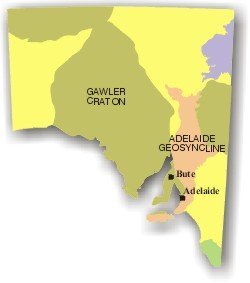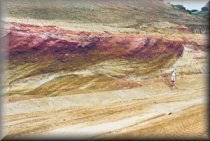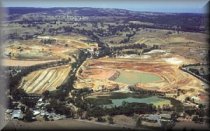 Large quantities of construction materials are consumed each year in South Australia in domestic and commercial buildings, as well as for building and maintaining the State’s infrastructure of road and rail networks and port facilities. In 1999, 10.03 Mt of crushed rock, 2.60 Mt of natural sand, and 0.43 Mt of brick and cement clay were consumed in the State. The total ex-quarry value of these raw materials was conservatively estimated at >$100 million.
Large quantities of construction materials are consumed each year in South Australia in domestic and commercial buildings, as well as for building and maintaining the State’s infrastructure of road and rail networks and port facilities. In 1999, 10.03 Mt of crushed rock, 2.60 Mt of natural sand, and 0.43 Mt of brick and cement clay were consumed in the State. The total ex-quarry value of these raw materials was conservatively estimated at >$100 million.
Construction materials are relatively low cost products, ranging in price from ~$6 to $24/t at the quarry gate. As transport costs are a major component of the final delivered price, sources are sought as near as possible to where materials are required. Most large country centres have quarries located nearby, and special purpose quarries are opened in remote areas to supply materials for projects such as construction of new roads and railways. A wide range of materials with diverse geological origins are therefore used throughout the State.
Crushed rock aggregates
By blasting, crushing and screening, quarries produce a range of products including coarse-screened rock for rail ballast, screenings for concrete, road sealing and hotmix aggregates, and crushed rock and rubble for road pavements. Large oversize ‘spalls’ of 1–8 t which are too large for the crushers to handle are often stockpiled for use in breakwater construction or beach protection works.In the Mount Lofty and Flinders Ranges, sedimentary rocks, principally quartzite, dolomite and limestone of Neoproterozoic or Cambrian age, are the most important sources of aggregate, but shale and siltstone are widely used in construction of unsealed roads. Port Lincoln derives most of its aggregate supplies from a quarry in Palaeoproterozoic Lincoln Complex granite. Mesoproterozoic acid volcanic rocks of the Gawler Range Volcanics suite are important sources of rail ballast north of Tarcoola, and road sealing aggregate at Kingoonya and northern Eyre Peninsula. Quaternary basalt deposits supply the Lower South-East with aggregate from the Mount Schank and Mount MacIntyre Quarries. One of the most widespread materials used for road building throughout the State is Quaternary calcrete; this material is particularly important on western Eyre Peninsula and in the Riverland where alternatives are not available.
Approximately half of the State’s crushed rock aggregate, including all supplies for the Adelaide metropolitan area, comes from two metasedimentary rock types of Adelaidean or Cambrian age:
- Carbonate — including dolomite, dolomitic limestone and limestone
- Quartzite — including sandstone and arkose.
Adelaide’s principal quarries and sand pits are shown in Figure 1. Production levels for the last 50 years are shown on Figure 2 and Figure 3. Two notable aspects of the graphs are:
- Cyclical nature of Adelaide’s construction industry
- Change in proportions of quartzite and carbonate aggregate produced.
Although a large range of products is made from both rock types, they are not fully interchangeable. For example, all of Adelaide’s road-sealing aggregate comes from carbonate rocks which bond more readily with bitumen than does quartzite. The quartzite quarries produce a relatively higher proportion of rubble, filling and quarry sand products and a lower proportion of screenings than carbonate quarries. Because of the greater versatility of carbonate aggregates and the fact that they are less abrasive and therefore cheaper to crush, they have been steadily increasing their market share in Adelaide for half a century. In 1946, only 10% of metropolitan aggregate production was carbonate, but in 1999 this had grown to 63%.
Stonyfell Quartzite is the source of all metropolitan quartzite aggregate, from Stonyfell, White Rock, Riverview, Para Hills and Salisbury Quarries. Eagle Quarry was closed and rehabilitated in 1999 during construction of the Adelaide–Crafers Highway.
Carbonate aggregate is sourced from a variety of units:
- Early Cambrian Fork Tree Limestone (Sellick Hill Quarry)
- Adelaidean Tapley Hill Formation (Noarlunga, Reynella and Linwood Quarries)
- Skillogalee Dolomite (Riverview and Montacute Quarries).
The majority of carbonate aggregate resources are located in the southern metropolitan area. Recent exploration has been concentrated north of Adelaide near Kapunda for new sources in Adelaidean sedimentary rocks. Large resources of Early Cambrian Kulpara Formation, which crop out extensively on northern Yorke Peninsula, are a potential supply for Adelaide’s long-term requirements for high-quality aggregates.
Natural sand
 Multicoloured sand in tidal channel exposed in a Maslin Beach sand pit. |
Natural sand is used for a variety of purposes for which there is a range of specifications, principally size gradings and silt and clay content. The most important use of natural sand is in concrete, which accounts for over half of all sand produced. Other significant uses include bricklaying, plastering, filling on building sites, packing of water or gas pipeline trenches, and for gardening.
Most regional centres have small pits to cater for local requirements. Dry creek beds are a common source of concrete sand in country areas, including northern Spencer Gulf, and Holocene dune sand is widely used for packing, filling and garden applications. Holocene beach ridge deposits of St Kilda Formation supply Port Lincoln, and Pleistocene Bridgewater Formation beach deposits are mined near Comaum in the South-East. Thick deposits of predominantly shoreface facies from the Tertiary Loxton Sand are mined from exposures in the Murray River cliffs near Berri and Paringa in the Riverland.
Prior to the early 1990s, almost all of metropolitan Adelaide’s annual requirements of ~2 Mt of sand came from Tertiary fluviolacustrine deposits on the eastern flank of the St Vincent Basin. Because of the relatively high clay content of these deposits (~15%), ~70% of production is treated by washing to meet specifications; most of the remainder is dry screened. For uses such as concrete sand, 5% is generally the maximum permissible content of silt + clay.
|
|
In the Maslin Beach – Pedlar Creek area, the Middle Eocene North Maslin Sand crops out along the northern margin of the Willunga Embayment. This is the only major source of construction sand south of the city, and two major sand pits are in operation. An equivalent unit in the northern part of the Golden Grove Embayment has two major sand pits, and two additional operators have acquired strategic reserves within the Golden Grove Extractive Industry Zone. Further north, remnants of Tertiary fluviolacustrine sediments which extend eastwards from Gawler to the Barossa Valley are mined for sand at East Gawler, Sandy Creek and Rowland Flat.
During 1991, a MESA mapping and drilling program between Bute and Ardrossan on northern Yorke Peninsula defined a 60 km long section of a palaeochannel containing sand tentatively correlated with the North Maslin Sand. Pits have been established near the town of Price in areas which are low in clay content and do not require washing. The higher cartage costs are substantially offset by savings in the processing costs, and in 1999 these pits supplied 25% of the total metropolitan natural sand market including, very significantly, 38% of the concrete sand.
Clay
Metropolitan Adelaide’s supplies of industrial clay come from two main sources — weathered shale deposits of Adelaidean Saddleworth Formation and Woolshed Flat Shale, and fluviolacustrine white plastic clay deposits in Tertiary sedimentary basins.Golden Grove is the centre of the clay brick industry in South Australia and accounts for >80% of the State’s clay brick manufacture. Production is from two modern plants operated by PGH and Nubrik, located close to major deposits of clay in the same Extractive Industry Zone as the sand pits. The bulk of clay used in brick blends is won from deposits of deeply weathered Adelaidean shale on the eastern flank of the Tertiary Golden Grove Embayment. The shale is blended with white plastic sedimentary clay, occurring as interbeds within the Tertiary sand sequence, to increase green strength of brick clay blends, improve extrusion characteristics and reduce firing temperatures. During recent years, increasing use has been made of reclaimed fine tailings from sand washing operations.
Total clay consumption in the metropolitan brick industry in 1999 was 0.31 Mt, with an additional 0.12 Mt being used in cement manufacture.
Additional Reading
Pain, A.M. and Keeling, J.L., 1990. Aggregate, sand and clay resources for metropolitan Adelaide. Mines and Energy Review, South Australia, 157:5-17.Pain, A.M., Valentine, J.T. and Hayball, A., 1992. Reconnaissance drilling of construction sand deposits, northern Yorke Peninsula, report no 1. South Australia. Department of Mines and Energy. Report Book, 92/56.



